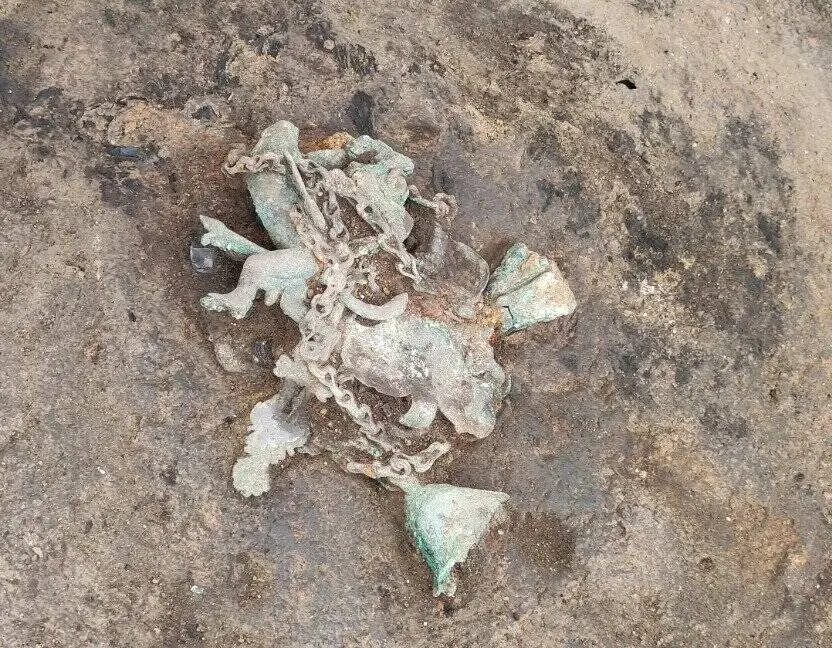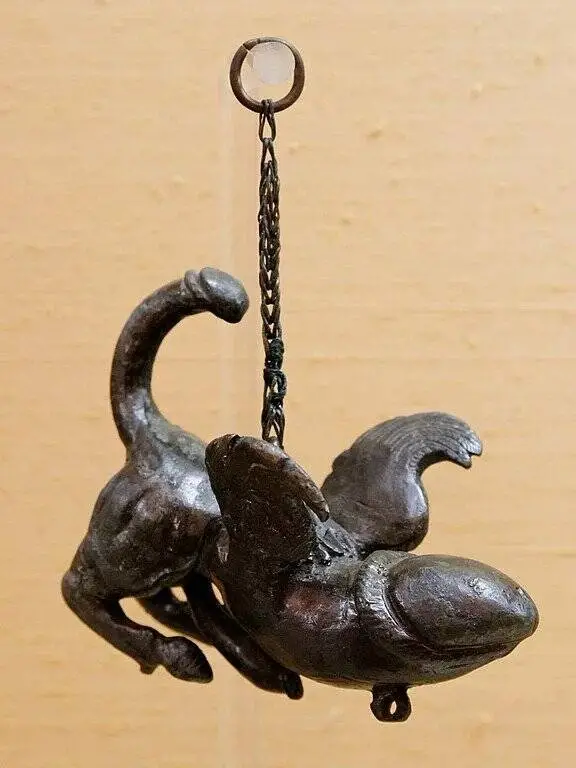The bronze wind chime phallus once hung at the entrance of a large home in the ancient Roman city of Viminacium.

Ilija Danković/Archaeological InstituteThis phallic wind chime is similar to others that have been found from the same period.
Archaeologists excavating the ancient Roman city of Viminacium in present-day Serbia recently came across an incredible object: A wind chime called a tintinnabulum that featured a large winged phallus.
“During the excavation of one of the main city streets, the gate of one of the buildings was discovered. It was established that the building was destroyed by fire, during which the porch collapsed and fell to the ground, and an object known in scientific circles as a tintinnabulum was discovered in the layer of rubble,” Ilija Danković, an archaeologist at the Institute of Archaeology in Belgrade, told Serbian-language website Sve o arheologiji.
Archaeologists are keeping the wind chime, made of bronze, mostly submerged in in the dirt for now so that they don’t damage it. But though its exact formation is partially obscured, they can roughly tell what it looks like.
“[T]he central part of the composition was the so-called fascinum, a magical being with a body in the form of a winged phallus on legs, with its own phallus and a tail in the form of a phallus,” the archaeologists told Sve o arheologiji. “Four bells were hung on the fascinum.”

Wikimedia CommonsA similar looking tintinnabulum from Pompeii in the first century.
Though phallic imagery is considered erotic, rude, or humorous today, ancient Romans had different ideas about phalluses. They believed it was a powerful object and phallic amulets were often worn by young children and soldiers for protection from harm.
“[A phallus] was a bringer of good fortune and happiness, and an efficient weapon to combat the evil eye,” Danković said according to Live Science. “For this reason, phalluses can be seen everywhere in the Roman world, from wine cups to the amulets worn by children.”
In the ancient Roman city of Viminacium, the owner of the phallic tintinnabulum would have embraced this interpretation and hung the wind chime for good luck and protection. As the archaeologists told Sve o arheologiji, Romans believed that adding wings to phallic objects made them more efficient at warding off evil.
“It was for this reason that the owner of the building in Viminacium hung the tintinnabulum in front of his gate,” the archaeologists explained. “He believed that this object had powerful magical properties that could help him.”
The fact that the homeowner hung the phallus also demonstrates how people living in Viminacium, though far flung from the center of power in Rome, shared Roman ideas. Danković additionally explained that the phallic tintinnabulum was likely made elsewhere and brough to Viminacium, which shows that social elites in the city had money to spend for such objects.

Ilija Danković, Archaeological InstituteThe phallic tintinnabulum was hung in Viminacium in hopes of bringing good fortune and protection from evil.
As History Daily explains, Viminacium was the provincial capital of the Roman province of Moesia Superio, located today near the town of Kostolac, about 30 miles from Belgrade. It was first occupied in the first century C.E., and eventually grew to be a bustling town of 40,000 residents.
Like many thriving Roman cities, it once contained a fortress, a hippodrome, an amphitheatre, a theatre, a forum, bathhouses, and many luxurious homes, like the one where the phallic wind chime was found. Like many Roman cities, however, Viminacium was also doomed. In 441 C.E. it was destroyed by Attila the Hun, then again in 582 C.E. by the Avars.
As Sve o arheologiji reports, archaeological excavations at Viminacium are just beginning, and the area promises to offer up new discoveries as they continue. But the phallic tintinnabulum seems to establish that the people who once lived in Viminacium thoroughly embraced Roman culture, traditions, and superstitions.
The discovery of the wind chime, Danković said, according to Live Science, proves that Viminacium was “in every sense a part of the Roman world.”





